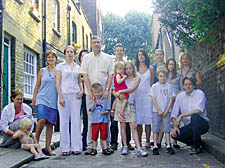|
|
 |
| |

Protesters in the street this summer
|
Developers move in on historical street
Lorry access row in one of borough’s oldest roads
DEVELOPERS wanting to use one of Kentish Town’s oldest and smallest streets to remove hundreds of tons of mud and masonry are sending engineers to dig holes in the cobbled road to work out the size of lorry they can use.
The developers want to send fleets of trucks down historic Little Green Street, off Highgate Road, to access a derelict former rail workers social club. They plan to build 30 new homes and say it is the only route possible.
But residents in the Georgian terrace say the cobbled street is too narrow to be used by heavy lorries bringing in building equipment and materials, and removing earth and debris.
Planning permission has conditions attached regarding access that architects and engineers are trying to resolve.
Resident Nick Goodall, who has helped run a campaign to stop the work and has collected over 1,500 signatures against the scheme, said sinking trial holes – work is due to start in the last week of January – to see how much weight the road can take ignored their fears.
He said: “Digging holes to find out the strength of this street does not mean the street will be wide enough, or that lorries coming back and forth would not damage our homes.
“These houses were built in a time when they did not underpin and have shallow foundations. This type of traffic would ruin them.”
The first house built on the street was put up in 1756. It has been used by historians to illustrate by-gone London, and film makers on location: pop group The Kinks used the street for the video of their classic hit, Dead End Street.
Architect Satish Patel, whose firm PTP are managing the project, said using the road was the only way to get to the site and the area would benefit from having new homes built.
He said: “We need to agree a method of getting on site. Little Green Street is the only option, and we need to work out how big the lorries we use should be and what times of day we can use the street.”
He added that the trial holes, which would be around a metre deep and at intervals along the gutter of the road and mean the road was closed to cars and bikes, would help make these decisions.
He added: “The reality is it has one access point. Either this will be done by us, or by some one else. We have planning permission and the site cannot lie empty forever.”
|
 |
|
 |
|